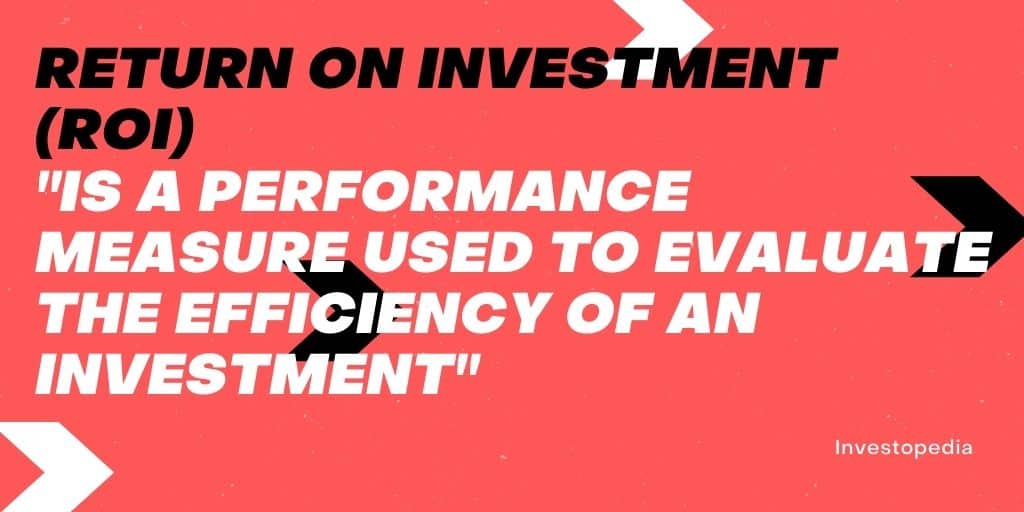According to Investopedia , ROI, or return on investment, is the ratio between the investment cost in a project over the profit you make from the investment. It is also a performance measure sured to evaluate the efficiency of an investment. If you want to assess the financial health of your budget, looking at an ROI calculation is a great place to start. In this guide, you will learn how to calculate ROI and see three examples of how to use ROI to help you make wise financial decisions for your business.
How to Calculate ROI:
Let’s start with a visual from Plan Projections:
At the top of the ratio, you’ll need the profit you made from the item that you are trying to determine your ROI for. To get the profit made, you can subtract the total cost of the item from the total revenue made (aka the investment). On the bottom, you will put just the total revenue or investment.
After you’ve done this, you’ll take your decimal number multiplied by 100 to get a percentage.
The higher the number, the higher your return on investment and the better an indicator that your particular business investment is a sound one. The lower the number, the more you may want to question how much you’re spending in this area of your business.
Let’s look at some examples.
Example One: A Good ROI
Every business can determine what a standard or good ROI is based on their market according to Entrepreneur .
Imagine this: you are managing a vacation rental property in Southern Florida. You’ve put together a fantastic property at a fair price, but you’re getting little traffic. So, you invest in a marketing campaign via social media to market to your target audience on Facebook.
Let’s say you’ve committed to spending $50/day for a 30 day period on Facebook ads. Your total investment is $1500 because you take $50 (the amount per day) multiplied by 30 (the total number of days).
After the 30 day period is complete, you can go to Facebook Ads and see how much traffic your site has gained, how many more clicks you have received, and thus how many more bookings you’ve completed from this campaign.
For this example, let’s say that during this 30 day period, your total revenue made as a result of this campaign was $1800.
To calculate the profit made, we take our total revenue $1800 minus the amount invested in the campaign $1500.
Your profit was $300.
We take the $300 profit divided by the total investment of $1500. And get .2. We are looking for a percentage so we take the .2 multiplied by 100 to get a 20% ROI.
What this means is that your profit was 20% of the initial investment. You made money on the investment and this is probably an investment worth repeating with the intention to see that number grow over time.
Example Two: An Okay ROI
There’s a small vineyard in Northern California that is looking to expand their sales by investing in an email marketing campaign, since most of their users come from email and they’d like to see more profit come in from this avenue.
Over 60 days, they invest a total of $2000 in email marketing campaigns to reach their audience. They either craft this campaign with their in-house marketers or they reach out to a local agency to help them develop a campaign that makes sense and educates their audience on their newest red wine blend.
Using a system like Hubspot helps them keep track of how much money their email campaign has made them. They will want to include links to blogs about their red wine blend, social media posts featuring the blend, and easy access to where customers can purchase their red wine.
After the 60 days has passed, the vineyard will want to look at how much money that campaign has made them. For the sake of this example, we will say that they made $2200 over the course of the 60 days.
Once again, they will take their total revenue from the campaign $2200 minus the amount invested $2000 and divide it by the total amount made $2200.
2200-2000/2200=.9
.9 x 100= 9% ROI
This final calculation depends on what your metric of success is. Many businesses will say that any positive number for an ROI means that it is an investment worth keeping because it simply shows that you made money.
However, consideration should be given to how much money is being invested and how much is being returned. There could be two great projects that are bringing in money with a positive ROI, but if budget cuts need to be made, then priority may need to be given to the project with a higher return on investment.
Example Three: A Negative ROI
Finally, we’ll take into consideration an ROI that is concerning and what to do if this happens.
A small repair shop is looking to get more calls for business. They’ve heard that social media is the key to making more meaningful contacts, but they didn’t take a look at who is already buying their services to see that none of them are on social media. They’re mostly checking their email.
Without this knowledge, the repair shop invests in Instagram, because they hear that it is popular right now. Because they think this is the way of the future, they are willing to pay a large amount to get more buyers in the door. They pull money away from other ventures to follow the popular trend right now with most people, even though their people aren’t actually on Instagram.
Over a 3 month period, they invest $5000 dollars into marketing on Instagram. They use Facebook Ads Manager to build out their Instagram campaign and wait to see the cash flow come in.
Calls do come in and they do make money, but its’ not at the rate that they had hoped.
Their total revenue for the 3 month period is $4400.
$4400-$5000/$4400= -.136
-.136 x 100= -13.6%.
This number shows that they lost money and thus their investment did not pay off. In almost any case, if the ROI is negative, then you will want to reconsider how you have spent your money.
In the case of this repair shop, they will want to look at other areas of their business to see where they are making money. In this instance, I’ve already mentioned that most of their current customers are using email so this would be a more wise investment.
Don’t always just trust what you read is trendy or popular. It can be easy to get sucked into those paths, but honestly every customer and every market is different. You want to be investing and getting money back on your people and your market. Developing your buyer persona (i.e. a semi-fictional representation of your customers based on real facts from your current customers) is key to developing a strategy for where to spend your money in marketing.
One Last Thing
We all have to start somewhere. You may find the amount of math overwhelming for a small business. Especially if you are juggling many balls all at once.
Start small and then work your way up through the various channels.
Begin by making a list of where all of your money is going, split them into major categories, and don’t forget to include time spent, as well. You may not be spending actual dollars on every part of your business, but the amount of time you are spending is important in your audit, as well.
After you have a clear idea of where your money is going, then you can dig into calculating ROI for various projects.
Need any help or have any questions? We’d love to hear from you and we’re always happy to help.















